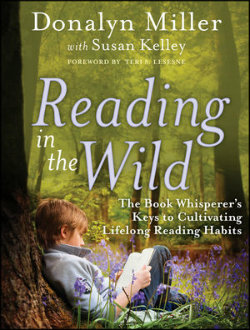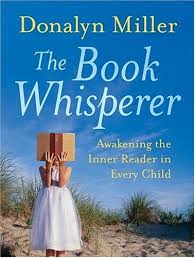Advanced Strategies Can Help Kids Become Wild Readers
Reading in the Wild: The Book Whisperer’s Keys to Cultivating Lifelong Reading Habits
By Donalyn Miller with Susan Kelley
(Jossey-Bass, 2014 – Learn more)
Reviewed by Tyler McBride
If you haven’t read Donalyn Miller’s The Book Whisperer [MiddleWeb review], drop everything and go read it. No, I’m serious – put down your tablet, laptop, or phone and immediately run to your local library or bookstore.
With The Book Whisperer, Miller became one of the premier reading workshop experts in the country, and rightly so. The book (drawing on research and Miller’s teaching experience) showcases reading workshop as a viable alternative to traditional instruction that can squelch the love of reading.

Reading in the Wild continues in the same vein of teaching and research. However, while The Book Whisperer is a general introduction to reading workshop and how to implement it in your classroom, Reading in the Wild is a resource for teachers who have already implemented workshop teaching and a refresher course to return us to what is truly important in our instruction.
Habits of wild readers
Miller structures the book around five habits of what she calls “wild readers” —
- Wild readers dedicate time to read.
- Wild readers self-select reading material.
- Wild readers share books and reading with other readers.
- Wild readers have reading plans.
- Wild readers show preferences.
In each chapter Miller discusses how she helps cultivate these habits in the readers in her classroom by using the workshop model of teaching, conferring with students, promoting books and reading to her students. Survey responses from student and adult readers support each chapter and provide insight into how reading for school should relate to what readers do in the real world.
The pieces of her writing that I found most helpful were her descriptions of how her students reflect on their reading and learning through inventories, surveys, and charts in their reader’s notebook. She never describes it this way, but the reading notebooks in her class basically function as interactive notebooks: full of taped-in charts, responses to literature, lists, reflection, etc. As an added bonus, all of the charts, surveys, and lists she gives to her students are reproduced in the book’s appendices and are valuable to teachers planning mini-lessons, discussions, and activities during reading workshop.
Choice reading in an age of accountability and standards
What I appreciate most about both of Miller’s books is how she provides a rationale for free choice reading in English classes at a time when teachers are increasingly being told to increase the rigor and intensity of reading instruction.
Some see choice reading as “too easy” – an activity that we just don’t have time for when we have so many standards to cover. Miller’s work (along with the work of others such as Nancie Atwell, Stephen Krashen and Penny Kittle) gives teachers practical instructional methods and a solid research base to implement free choice reading. Her work lends support to teachers who might be trying to convince their administrators and colleagues that reading in class is a worthwhile activity.
The implied argument about reading instruction in much of the education world today is that students do not know how to read closely and analyze texts. Therefore, some seem to say, we must plan more whole-class instruction, group work, or technology integration that focuses on reading and analyzing texts that the whole class reads together.
Miller’s argument is that many students are leaving our classes with a bad taste in their mouths from reading. To make students engaged, lifelong readers, she advocates giving students voice and choice in what they read and allowing students time to actually read in class. Only after we have engaged students in the process of reading (as opposed to doing activities about reading) can we teach students to analyze what they read and think deeply about a text.
A small success story
After reading Nancie Atwell’s In the Middle (widely regarded as the manual for workshop teaching) and Penny Kittle’s Book Love (focused on implementing reading workshop in a high school setting), during the 2012-13 school year I was inspired to give my students more choice and time to read in class.
I then started reading Donalyn Miller’s work and became even more inspired. My ideas, methods, and class procedures for workshop teaching are still evolving, but I am seeing the benefits of it.
In the middle of the fall semester of 2013, a new student joined one of my 8th grade classes. We’ll call her Rachel. After I started explaining our daily independent reading time and asking what she had read before, Rachel admitted she had never completely finished a chapter book, aside from the books that had been read to her in previous grades.
When our class went to the library, I encouraged her to find a book that she liked, and she browsed through the shelves. After a while, she found a book and checked it out. She took it home, read it, and brought it back a few days later with a beaming smile on her face.
“I finished it!” she proclaimed.
“Did you like it?” I asked.
“I loved it! Do you have any more books like this?”
Since then, Rachel has devoured book after book, and her whole attitude about school and reading has brightened. It’s amazing what books can do.
I would love to say that I am responsible for Rachel’s love of reading, but I’m really not. I just attempt to create an environment in my class every day that encourages reading and thinking. Then I step back and let the books do their magic, with my support along the way. Essentially, that’s all there is to the workshop method of teaching. It’s a simple idea, but it takes time and complete commitment to make it work.
There is no secret formula
If you are expecting a secret formula for teaching reading, or a one-size-fits all manual for teaching, do not look to Reading in the Wild. Teaching reading is just not that simple. Even in the workshop model, some students still struggle to be engaged with reading. You will never get it “right” and what works in my classroom or Miller’s classroom may not work in every teacher’s classroom.
That said, Reading in the Wild does provide ways that reading can breathe new life into your classroom, and it gives inspiration that the world could be a better place if more students left our classrooms in May as wild readers.
Tyler McBride teaches 7th and 8th grade ELA at Greenland Middle School in Greenland, Arkansas. Tyler is in his second year of teaching and has presented his teaching and research at state and national conferences. His blog, Common Sense in ELA, documents his experiments with and rationale for workshop teaching. He currently lives in Fayetteville, Arkansas with his wife, Vasti, and their dog (Molly), cat (Butter), fish (Martha), and two parakeets (Midnight and Comet).
Editor’s note: Donalyn Miller shares “Five Teaching Tips for Helping Students Become ‘Wild Readers,’” adapted from her book, in this Education Week article.



































